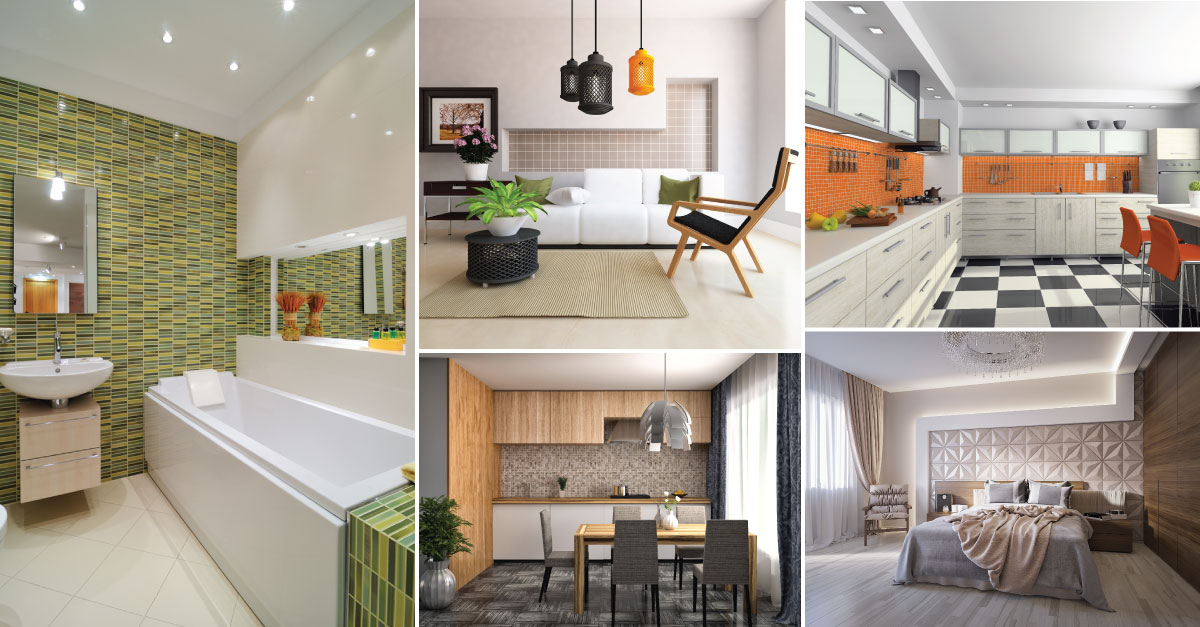Tiles are one of the greatest inventions when it comes to home décor. They aren’t just pretty to look at, but are also strong and durable in the face of everyday use (and abuse!)
Which makes them – a big investment towards making your home easy to maintain, hygienic and beautiful. So, here’s a quick lowdown on everything about tiles that you need to know, that’ll help you make yours with confidence!

So How Many Kinds Of Tiles Are There Really?
1. Vitrified tiles
These are inexpensive tiles that are treated to make them resistant to stains, scratches and acids.
2. Cement Or Concrete Tiles
As you would expect, these tiles are strong, long-lasting and anti-skid and best for exterior floors.
3. Terracotta Tiles
These are tiles made from clay and are glazed to make them more durable and attractive. They are a good choice for living rooms.
4. Ceramic Tiles
These can be glazed or unglazed and are great for both walls and floors.
5. Mosaic Tiles
More popular in kitchens and bathrooms, these are small tiles that can add a pop of color to any room. They can be glazed or unglazed and are made from porcelain, stone, glass or ceramic.
6. Tiles Made From Natural Stones
These include limestone, marble, granite and many others, used in living rooms, bathrooms and even kitchen counters.
7. Quarry Tiles
Mostly preferred in kitchens, these unglazed tiles make a great flooring option, both inside and outside the house.
The 5 Golden Rules Of Tiling
1. Rule No. 1
Okay. This rule has a couple of rules built into it. Use vitrified tiles for the floor in high-traffic areas of the house as they tend to camouflage wear and tear and dirt well. Keep terrace tiles basic and light colored as that reduces the temperature of the space. You can use glossy ceramic ones for walls to keep stains to a minimum. And last but not the least, lighter colors will also make the space look larger, but darker colors are easier to maintain.
2. Planning ahead
It’s a good idea to buy about 10% more tiles than you would need, rather than hunting for the same design later, when you have a breakage and want to replace a tile or two.
3. Size Does Matter
Don’t get large tiles for a small room as it will make the room appear smaller. Medium sized tiles would work well in such rooms. Also, pick a tile size that’s a multiple of the room size as that’ll reduce cutting and wastage.
4. Get The Grouting Right
Match the grout with the tiles and keep grout lines as thin as possible so that they are less visible.
5. Mix Them Up!
Experiment with 2-3 tiles to lend visual interest to a space. On floors it could be a border of a different color. On walls it could mean a combination of mosaic, metallics or patterned tiles with plain ones to create a unique look. If you aren’t great at taking creative risks, tile manufacturers today have pre-set tile combinations that they sell as a concept.
Let’s Look At Tiles For Different Rooms Now
The Bathroom
Ceramic tiles are the best option for bathrooms and it’s best to use 3” x 6” tiles here.
Get non-skid matte ones in bright colors for the floor and the easy to clean glossy or satin textured ones for the walls. You can even decide to go all out and give this space plenty of personality with floral designs and colorful borders.
The Living room
From basic ceramic ones to designer marble tiles, you can choose anything for your living room. Terracotta tiles will make a small living room appear warm while natural stone tiles would work well with larger living spaces.
It’s a good idea to save the smaller tiles for smaller rooms like bedrooms and use large tiles for the living room. Ivory and grey are good neutral options that work with all styles of décor.
The Kitchen
For your kitchen ceramic tiles can be a great choice. They are durable and come in a wide variety of colors and styles. It’s a good idea to choose ones that are scratch and stain resistant. And keep your cabinet and countertop color in mind when selecting wall and floor tiles for your kitchen. But generally, golds and browns would work well as stains aren’t easily visible on them.
Use anti-skid ones for the floor for better grip and glossy ones for the walls that will make cleaning easy. Also, use small tiles for a small kitchen and large tiles for a large one.
Source: Homebliss










